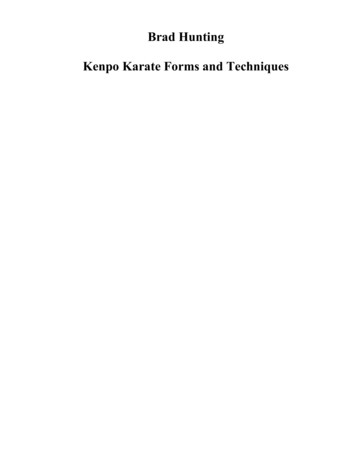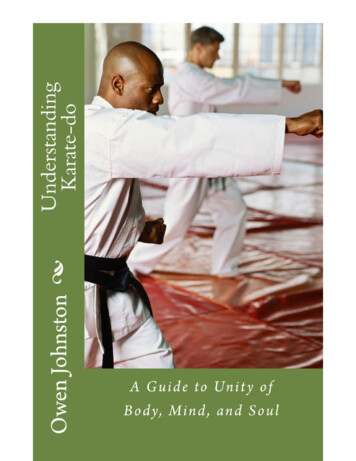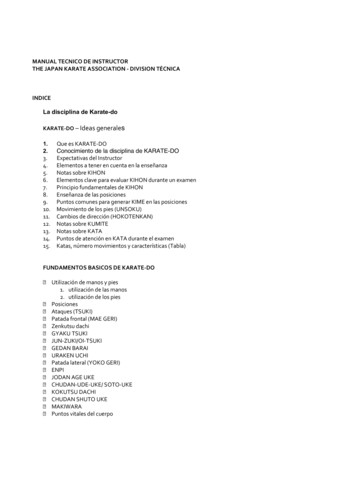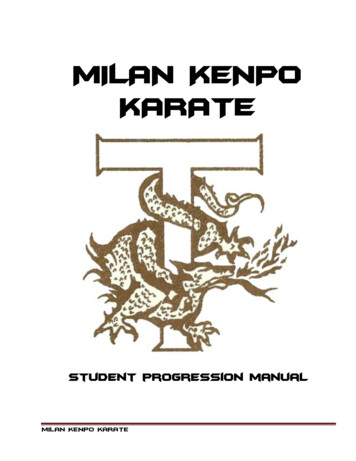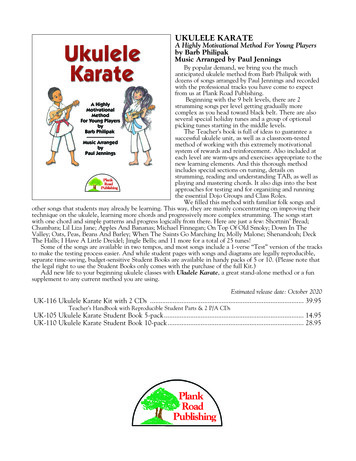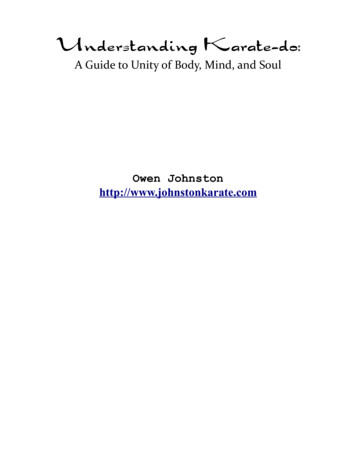
Transcription
Understanding Karate-do:A Guide to Unity of Body, Mind, and SoulOwen Johnstonhttp://www.johnstonkarate.com
2Understanding Karate-doLegal & Author InformationCopyright Information:Johnston, OwenUnderstanding Karate-do (version 1.0)Copyright 2005-2011All Rights Reserved. The PDF version of this book may be freelydistributed or copied for personal or classroom use. Do not directlysell this book without contacting the author first and becoming anofficial reseller.This guide is also available as a professionally bound andprinted trade paperback for only 7.99, and available for Kindle atonly 0.99. Please help our dojo defray costs and keep tuition low bypurchasing a copy and/or sharing the link with others :)https://www.createspace.com/3612943Or http://www.amazon.com and search for Understanding KarateAuthor & Publisher:Owen Johnstoncyriades@yahoo.comJohnston Karate Home Page:http://www.johnstonkarate.comDon't forget to visit the site for all of our books and videos,which are provided freely. Simply click the link at the top of thepage that says 'Free Karate Downloads'.
3Understanding Karate-doTable of ContentsIntroduction- 5A Brief History of Karate- 6A Brief History of Wado Ryu- 11Karate Lineage- 15Karate Principles for Self Defense- 18Basic Techniques and Drills- 21Kata- 25Philosophy (dojo precepts, bowing, etc) - 33Terms (Japanese pronunciation etc)- 34Karate Precepts- 35Karate Principles- 36Strategy- 37Peace, Harmony, and Truth- 40On Teaching- 41Walking the Path- 42In Pursuit of Perfection- 44In Pursuit of Perfection II- 45In Pursuit of Perfection III- 50Sources and Recommended Viewing- 57
Understanding Karate-do:A Guide to Unity of Body, Mind, and SoulOwen Johnston2005-2011'The true purpose of budo is the search for truth. In karate,three elements are important - physical strength, spirit and heart.The end of do (the way), cannot be achieved in a few years, rather itis a lifelong search. Perhaps you could say the aim is to make usgood Human Beings.'- Ohtsuka Hironori (6/1/1892 - 1/29/1982), founder of Wado ryukarate
5Understanding Karate-doIntroduction'The Way is not meant as a way of fighting. It is a path onwhich you travel to find your own inner peace and harmony. It isyours to seek and find.' - Ohtsuka HironoriKarate-do, as a tool for self-improvement in one's own life andfor the lives of others, is rivaled by few other disciplines onearth. It may be practiced nearly anywhere, anytime, and by almostanyone, especially its code of conduct. It is not necessarily areligion, but indeed a discipline that one may apply to one'sexisting beliefs. It is simply one of many methods by which one maystep onto the path of becoming the best person one can possibly be,where one's ultimate teacher will be life itself.No book can replace formal, technical instruction; as such, thisbook is primarily designed as a companion guide for the existing orprospective student of Karate-do. Also, as this book is a constantwork in progress, I realize that the histories and lineage providedare far from comprehensive. However, I do hope that they are passableas basic, concise sources. For more comprehensive information aboutthe wide world of karate and more, check out my Sources andRecommended Viewing.My lineage: I earned the rank of shodan in Heiwado (JapanInternational Karate Center's karate) from Sensei Craig McKenzie. Hewas taught by Sensei Kevin Marshall, who in turn was taught by SenseiDale Coker. His teacher was Shihan Ronald Woodard. My particularformulation of Heiwado is based on continued research. More lineageinformation is found in Part I of the book.Author & Publisher:Owen Johnstoncyriades@yahoo.comJohnston Karate Home Page:http://www.johnstonkarate.comDon't forget to visit the site for free supplementary materials.Click the link at the top of the page that says 'Free KarateDownloads' for free videos and other guides.
6Understanding Karate-doA Brief History of KarateKarate-do, in all its various forms, finds its origins in oneplace - the Ryukyu islands off the coast of Japan. What we know asone of the most widely practiced systems of self defense anddiscipline in the world is the result of centuries of development.While Karate-do was introduced as a code of ethics to a peacetimeAmerica only a few decades ago, it began through the need of Ryukyunatives for better methods of fighting.There are a few theories about the origins of the fighting artsthat later became collectively known as Karate-do. However, it iscertain that many notable Chinese kung fu practitioners settled inOkinawa, the capital of the Ryukyu kingdom.The origins of the Chinese arts themselves are also shrouded inthe mists of time. A widely accepted theory is that Bodhidharma, thefounder of Ch'an (Zen) Buddhism created what would later evolve intoShaolin kung-fu. The original exercises were used to strengthen hismonks' bodies, minds, and spirits, to help them better fulfill theirduties. This level of personal cultivation carried across to manyChinese martial arts. By way of transmission to other countries, thiscarried across to other martial arts, Karate-do being one of them.In the year 1429, a weapons ban was passed by King Shohashi.This led to the rapid development of native unarmed fighting arts.These arts were primarily influenced by various forms of Chinese kungfu, which Okinawans began learning in the 14th century.Okinawans learned forms of Shaolin kung fu from Shaolin masterswho fled China as a result of the oppressive Qing dynasty. Okinawansalso learned various forms of kung fu from Chinese merchants, Chineseofficials on diplomatic missions, and young members of wealthyOkinawan families who went to China to learn 'Quan Fa' / kung fu tofurther their education and martial arts studies. The general namegiven to the fighting arts learned and further refined by theOkinawan martial artists was tode-jutsu (alternately spelled tou-di),the Okinawan name given to Chinese martial arts.In February 1609, invasion of Okinawa by the Satsuma clan (ofKyushu, Japan) triggered another period of rapid development ofnative Okinawan fighting arts. Satsuma control lasted until 1879,when the King of Ryukyu finally abdicated and the country became partof Japan.During this period, kobudo (often translated 'classical fightingmethod'; commonly used to represent Okinawan weapon fighting)evolved. Farm implements were used as weapons, as traditional weaponswere not allowed. However, some of the native Ryukyu warrior classtraveled up to the Satsuma clan in the later part of the 19th centuryand learned their samurai fighting art Jigen-ryu kenjutsu. It was notlong after this that Sokon Matsumura, 'Toudi' Sakugawa, and Tsuken
7Understanding Karate-doA Brief History of Karate continuedKoura, among the many who had made the trip, introduced theircontributions to kobudo.Ultimately, three major strains were developed from Ryukyu kenpokarate-jutsu (as tode-jutsu eventually came to be called). Thesestrains were named Shuri-te, Naha-te, and Tomari-te, for the regionsin which they were developed. All three regions are based in thesouthern part of Okinawa. The differences of the three styles may betraced back to the socio-economic status of those who practiced them.The lowest rung on the ladder was the worker class studying TomariTe. The middle section was the merchant class studying Naha-Te. Theupper class noblemen were taking up practice of Shuri-te in andaround the capital.Matsumura is commonly considered the great grandfather of thekarate movement in and around Shuri. He learned native Okinawanfighting from Sakugawa (who in turn learned from Kusankun and othermasters). He later studied in Fujian and Satsuma. He learned ShaolinBoxing (Shorin-ryu) under the tutelage of master Iwah. As a result ofthe efforts of Matsumura, the fighting arts that surfaced around thenoble / castle district of Shuri came to be known as Shuri-te (Shurihand).The Chinese master Ason taught Zhao Ling Liu (Shorei-ryu) toSakiyama, Gushi, Nagahama, and Tomoyori of Naha. This led to thedevelopment of Naha-te. Naha, a coastal city, was a large tradecenter at the time. Xie Zhongxiang (nicknamed Ryuru Ko) of Fuzhoufounded Whooping Crane kung fu (hakutsuru) and taught it to a numberof notable karate masters in the Fuzhou province. Wai Xinxian, it issaid, was a Qing dynasty officer, and taught Xingyi kung fu as wellas Monk Fist Boxing. It is also said he assisted Master Iwah'sinstruction in Fuzhou province.Two separate, modern styles developed from Naha-te: Goju-Ryu andUechi-Ryu. Goju-ryu stresses deep breathing methods (ibuki). Itskata, including Sanchin, tend to utilize dynamic tension for powertraining. Uechi-ryu uses a number of kata that Kanei Uechi (18771948) learned while in China, as well as several Goju-ryu kata.Uechi-ryu's Sanchin is done with open hands, and doesn't use the deepbreathing emphasized by Goju ryu.Naha-te's Chinese lineage can be seen through the influence ofthe forms and methods of Crane and other styles. Dragon Boxingincludes the forms Seisan, Peichurrin (also known as Suparimpei),Saam Chien, and Eighteen Scholar Fists. Tiger Boxing also includesSaam Chien and Peichurrin, as well as Sanseiru and others. ArhatBoxing (Monk Fist) has Saam Chien, Seisan, Jitte, Seipai, Useishi,Peichurrin, and other forms.
8Understanding Karate-doA Brief History of Karate continuedWhile Karate was primarily organized in Shuri and Naha, Tomarioriginally had little direct influence. This is because, at thattime, Tomari was inhabited by a simple people; it was a working classcity of fishermen. Tomari had its share of notable masters, however,with Kosaku Matsumora (1829-1898), Kokan Oyadomari (1827-1905) andGikei Yamazato (1835-1905) the most notable. They studied underAnnan, as well as Ason, a Chinese sergeant.Tomari was located near Shuri, and its fighting arts developedpartly under its influence. Some of the Chinese masters who taughtTomari villagers, however, did not reach Shuri. Some of theseteachings did later influence Shuri-te, as exchanges eventually tookplace. Many of the kata became part of both Shuri-te and Tomari-te.Some of the kata unique to Tomari-te, however, are Wansu, Rohai, andWankan. It is believed that Chotoku Kyan (1870-1945) brought the kataAnanku from Taiwan in 1895. It is said there are other kata that havebeen lost over time.It is also said that a pirate or sailor (named Chinto, or Annan,depending on the source), was a castaway from a shipwreck on thecoast. He took refuge in the graveyard of the mountains of Tomari,and later lived in a cave. Reportedly, Sokon Matsumura formulated thekata Chinto (a.k.a. Gankaku) from the sailor's White Crane Kung Futeachings. Chinto kata, of which there are more than half a dozenversions, was adopted into shuri-te. The Tomari-te chinto kata has aChinese flair, in contrast with the simpler looking shuri-te version.A one legged stance occurs many times, bearing the image of a cranepoised to strike its prey. The flying kicks of this katadifferentiates it from others.Matsumora and Oyadomari apprenticed under local masters KishinTeruya (1804-1864) and Giko Uku (1800-1850). They learned from Teruyathe kata Passai, Rohai, and Wanshu, and from Uku, the kata Naifanchi.Matsumora was also versed in the jo-jutsu (short staff technique) ofJigen ryu. It is often said in Okinawan sources that Matsumora isAnnan's successor. Yamazato followed Matsumora and Oyadomari, whowere close friends. Both masters encouraged their students toexchange techniques and kata, furthering the development of Tomarite. Tomari-te became a light form of fighting, with plenty of feints.The kata Seishan is named after a well known Chinese martialartist who lived in or near Shuri circa 1700. He was associated withTakahara Perchin, a map-maker who was the first to teach TodeSakugawa. The kata is said to be the oldest still in use, andtranslates to '13' or '30'. The naha-te Seisan has a Chinese flair.The movements are repeated in sets of three, and has pivots andturning of the head. Hangetsu, the Japanese name for Seisan,translates to half-moon. This is taken from the stances and footwork,
9Understanding Karate-doA Brief History of Karate continuedas well as the hand movements, which use circular paths. As with manyother forms, the kata's movements differ slightly between styles.Throughout this period, tode-jutsu was taught primarily forhealth, philosophy and self defense. In this way, the Chinesetradition was continued. Tou-di, the karate of old, was not meant forthe competition seen in modern karate. In fact, there were no publicclasses, as practicing fighting was forbidden as a way to promotepublic order. The to-de masters chose their students with cautionbecause they were liable for problems that could arise (andfrequently did) from their students' actions. Tode-jutsu had alsobecome a part of the imperial guards' training. As a result ofOkinawa's annexation to Japan, however, there was a huge unemploymentboom, and poverty spread heavily. Because of this, a number ofchikundun peichin (those who upheld public order in the Ryukyukingdom) started teaching tode-jutsu for money.In the Satsuma occupation's later years, Japan began majorchanges as a result of the Meiji restoration. Cultural reforms led tothe abolition of the feudal system, the abasement of the samuraiclass, and development of democracy. However, democracy was neverfully implemented, nor were all the ideas of the samurai code and thefeudal system totally abandoned. Japan did not want to totally loseits strong identity to (primarily Western) foreign influences. Partof this identity was the bugei (martial arts), which assisted in theshaping of modern Japan.The budo (martial ways), as they came to be called, were morethan simply a cultural recreation. The ruling elite used the spreadof budo to further instill moral virtues, the values of bushido (wayof the warrior), and 'Japaneseness' in the Japanese public. In thisPre-World War II age full of increasing militarism, Japan neededstrong, able men who were willing to fight to the death. Japan alsohoped that young men of good health and mind would be more productivecitizens.As a result, many budo were introduced to the school system.Some of these classical budo included Aikido (The Way of SpiritualHarmony), Jiu Jitsu (unarmed self defense art often focused ongrappling), and Kendo (Way of the Sword), derived from the samuraifighting traditions. Also, Judo ('Gentle Art') was developed from jiujitsu in the later part of the 19th century.Itosu Anko led a group of Okinawan karate-jutsu experts in acampaign to introduce the art to the Okinawan school system as a formof exercise. Many of the dangerous applications were not practiced inthe school system, transforming karate from a hidden art of selfdefense into a unique recreation.Karate was introduced in this form to the Japanese mainland in
10Understanding Karate-doA Brief History of Karate continued1917. The Japanese martial arts association ('Dai Nippon Butokukai')was interested enough in karate to invite the art's bestpractitioner. Their intent was to compare karate-jutsu to Japanesejiu jitsu in matches of skill.Gichin Funakoshi was an Okinawan native who taught at the school'Shoto Gakko', which prepared Okinawans for Japanese civil service.His life's passion, however, was karate. Because of the respect hecommanded from Japanese gentlemen, and his skill in karate, he wasselected to represent Okinawa's martial art.He defeated every opponent he faced at the demonstration, andwon great respect. Because of this and his love of Japanese culture,he stayed on the mainland to further propagate karate. As a result ofthe first and further exhibitions, he gained many followers andultimately began teaching out of a Kendo dojo.At first, there were cultural barriers and traditions thatslowed the progress of karate across the mainland. As a result ofFunakoshi's excellence in teaching, however, he broke through theprejudices against karate. Eventually, he was able to open his owndojo, which was the first formalized karate dojo. Also during thistime, karate as a whole came to be formalized and 'Japanized'(although divisions among separate karate styles have not, to thisday, been resolved - primarily due to pride and organizationalpolitics).Such formalization included acceptance of the kyu/dan(class/grade) system as devised by Jigoro Kano (founder of judo).Also, it became important that all teachers were qualified andknowledgeable. Finally, it was necessary to institute a standardcurriculum, uniform, and competitive format.Nationalism and anti-Chinese sentiment made the karate-jutsumovement consider a more appropriate ideogram to represent their art.The original 'kara' ideogram of karate meant China, as did the 'tou'of toudi (Chinese hand, and a reference to the Tang dynasty). Thereplacement ideogram means 'empty', and takes on not just a physicalbut a spiritual meaning. 'Kara' may represent the 'void', and freedomfrom worldly desire.Also changed was the suffix for karate. Instead of jutsu(art/science), do (way/path/totality, pronounced 'dao' in Mandarin)came to be used. In this sense, as a result of the efforts of suchmasters as Itosu, karate-do joined kendo, jiu jitsu, aikido, and judoas a modern budo, in which not only combat is practiced, but also acultural discipline for the pursuit of harmony.
11Understanding Karate-doA Brief History of Wado ryuHironori Ohtsuka founded Wado-Ryu, the 1st Japanese form ofKarate in 1938. It was the result of many years of training invarious forms of Japanese Jiu Jitsu and Okinawan Karate, as well asAikido, developed into a single fluid, powerful, yet peaceful martialart. Wado-Ryu Karate is the Way of Peace and Harmony, and ispracticed as a way of life by millions of people worldwide.For such a relatively new and widely practiced martial art,details of its origin are either scarce or hotly debated. There isalso plenty of speculation and rumor. I will give as factual anoutline of the history as I am able. Also, I apologize beforehand ifit seems that any part of this history is vague, which is a result ofthe lack of facts pertaining to that particular section. For a morecomprehensive study of Karate, Wado-Ryu, and Ohtsuka-sensei, pleaserefer to Sources and Recommended Viewing.Ohtsuka began his martial arts training very young. His greatuncle Chojiro Ebashi began teaching him Jiu Jitsu (alternatelyspelled jujutsu and jujitsu), a grappling oriented art beginning atthe age of 3 or 4. He was later enrolled around age 5 or 6 in shindoyoshin-ryu jujutsu ('Sacred Willow Style' jujutsu) under ShinzaburoNakayama-sensei. This form of Jiu Jitsu was founded by KatsunosukeMatsuoka, a student of Yoshin-ryu jujutsu ('Willow Style'), in theearly to mid 1800s. Shindo Yoshin-ryu emphasizes grace and naturalmovement.This study of natural flowing movement later played a major rolein the development of Wado principles, along with Ohtsuka's traininglater in life under Morihei Ueshiba O'Sensei, founder of Aikido. Theuse of the opponent's momentum are as important in defeating him orher as your own movements. Also, Jiu Jitsu's orientation towardsrugged practicality influenced Ohtsuka's modifications to the Karatetechniques he would later learn.The Jiu Jitsu community of that time generally retained many ofthe Samurai traditions and fighting arts from which Jiu Jitsu itselfwas derived. Shindo Yoshin Ryu Jiu Jitsu, for example, containedKenjutsu influence and a heavier emphasis on striking than many otherJiu Jitsu forms. The Kenjutsu side was a definite influence on thebody shifting and hand controlling techniques Ohtsuka later includedin Wado-Ryu.Ohtsuka continued his study of Jiu Jitsu for many years. Duringhis period at Waseda University (from 1910-1917, where he earned hisAssociate's Degree in Economics) he experimented with various JiuJitsu styles to find their best qualities. Even this early on,Ohtsuka began evolving his techniques and principles.According to many, on June 1st 1920 Ohtsuka was promoted to 4thGrandmaster of Shindo Yoshin Ryu Jiu Jitsu. This has been much
12Understanding Karate-doA Brief History of Wado ryu continueddebated, however. The 3rd grandmaster of Shindo Yoshin Ryu, TatsuoMatsuoka (grandson of the art's founder), did not pass away until1989, 7 years after Ohtsuka's death. Also, Ohtsuka's instructor,Nakayama, had previously branched off from the founder to begin hisown style and lineage of Shindo Yoshin-ryu. It is also heavilydebated as to how much or little of the actual shindo yoshin-ryujujutsu curriculum was later adopted into Wado ryu. Also, Ohtsukahad, at some time during the early 1920s, been awarded a 'menkyokaiden' certificate. This certification essentially meant he hadgained full proficiency in the system. At the very least, Wado washeavily influenced by the shindo yoshin-ryu principles, and some ofits waza (techniques).Nonetheless, Ohtsuka's path as a budoka was set by this point,and would soon take its first fateful turn. He would soon meet thefather of modern karate, Gichin Funakoshi. In the fall of 1922,Ohtsuka was giving thought to his future. Although his job at thebank appeared secure, he was not satisfied. He wanted to devote hislife to his true passion, the martial arts. This interest washeightened even more when Ohtsuka found out that an Okinawan schoolteacher, Gichin Funakoshi, was invited by Crown Prince Hirohito toperform karate before the Emperor of Japan at a public hall in Tokyo.Ohtsuka attended the demonstration, and as a result became one ofFunakoshi's 35 original Japanese students.Because of the popularity gained by the demonstration, Funakoshistayed in Japan. Ohtsuka was at Funakoshi's dojo nearly every night,absorbing the art. By 1924, he became chief assistant instructor. OnApril 24th, Ohtsuka was named among the first seven black belts inmodern karate.Funakoshi came to rely heavily on Ohtsuka. At 32, Ohtsuka'srealized his dream of being a full time martial artist. However, hefound Funakoshi's karate (later named Shotokan) lacking. He feltthere was little sense behind the philosophies, the kata seemed tohave no practical application, and the movements were too confined.Also, Funakoshi did not allow free sparring, leaving no way to trulytest his karate. Therefore, while still assisting Funakoshi, Ohtsukatrained with other notable masters. These included Kenwa Mabuni,founder of Shito-Ryu Karate, as well as Choki Motobu, famous for hisexcellent technical and fighting abilities, and Morihei Ueshiba,founder of Aikido.Ueshiba O'Sensei helped Ohtsuka find the missing link, andofficially begin the creation of Wado. Like Shindo Yoshin Ryu JiuJitsu, Aikido is a direct descendant of Aikijujutsu (a part ofSamurai combative). The greatness of Aikido is in its reliance onnatural movements, focusing on breathing, relaxation, and 'ki' (lifeforce; breath; spirit). Whereas most karate tended to generate
13Understanding Karate-doA Brief History of Wado ryu continuedtension in performing techniques, Aikido was the opposite. Instead ofmeeting force of force, it blended with and redirected the opposingforce or ki.It was upon learning Aikido that Ohtsuka-sensei began to form anew budo, a Way of Harmony. He would eventually blend the basics ofFunakoshi's karate, the practicality of Shindo Yoshin Ryu Jiu Jitsu,and the spirituality of Aikido, as well as the natural, evasivemovements of the latter two. Much like the Jiu Jitsu influence onOhtsuka-meijin's budo, Aikido had more influence on the principlesfrom which techniques are derived, rather than the specifictechniques themselves. Also, it would appear that Shito ryu Karateand Shindo Yoshin Ryu Jiu Jitsu had a much heavier influence on Wadothan Aikido.Ohtsuka gradually incorporated knowledge from Jiu Jitsu, Aikido,and the other karate sensei he trained with, into the classesFunakoshi-sensei had put him in charge of. This included freefighting, and weaving his newfound principles into the kata. Whilemany students agreed with the changes being made, Funakoshi-senseiviewed them as contrary to his teachings. Due to their disagreements,it was in 1930 that Ohtsuka-sensei and Funakoshi-sensei finallyparted ways.Over the 4 years that followed, with help from students who alsoleft Funakoshi's instruction, Ohtsuka continued his own teaching.Constantly developing his new budo, he focused on deriving practicaldefense from formal art. A major breakthrough was the idea of KihonKumite Kata, which became his greatest contribution to martial arts.In blending Jiu Jitsu, Aikido, and Karate, he created not only 36 newkata, but a new budo.Ohtsuka-sensei created the All Japan Karate-do ResearchOrganization (Dai Nippon Karatedo Shinko Kai) in 1934, afterencouragement from many of his students. Also, his son Jiro (laterknown as Hironori Ohtsuka II), who would later become Ohtsuka's heir,was born that same year.Four years later, the All Japan Classical Martial Arts Festival(Dai Nippon Kobudo Tai Kai) invited Ohtsuka-sensei to demonstrate hiscontroversial new style. He was asked to name the style prior to thedemonstration, and he registered it as Shin Shu Wado Ryu Karatejujutsu - New Style Way of Harmony School. The year after, when DaiNippon Butokukai requested all Japanese martial arts and their chiefinstructors register their names, Ohtsuka-sensei gave the name WadoRyu - Way of Peace and Harmony.Ohtsuka-sensei continued teaching, and Wado-Ryu eventuallybecame one of the most highly regarded Japanese martial arts. The 1stAll Japan Wado-Ryu Karate championships were held in 1955. In 1963,
14Understanding Karate-doA Brief History of Wado ryu continuedMr. Arakawa, Mr. Takashima, and Mr. Tatsao Suzuki left Japan to helpspread Wado-Ryu Karate to Europe and America. Emperor Hirohito in1966 awarded Ohtsuka-sensei with The Grand Order of the Rising Sun(Kyuokujitsusho). In 1972, the president of International MartialArts Federation (Kokusai Budo Renmei) awarded Ohtsuka the title of'meijin' (master), the first time a karateka had been given such anhonor in Japan. Even now, many years after his death in 1982, peopleall over the world are still being affected in a positive way byOhtsuka's Wado-Ryu Karate-do, which is his ultimate honor.
15Understanding Karate-doKarate LineageAny further worthwhile information is accepted and appreciated.Sokon MatsumuraStudent of Kong Su Kung/Kushanku and SakugawaMatsumura taught Okinawan Shuri-te which later became known asShorin-Ryu. This form was a combination of Sakugawa's tode, and KongSu Kung's Chinese Boxing.Yasutsune ItosuStudent of Sokon MatsumuraItosu-sensei continued Shorin-Ryu as it was originally taught byMatsumura-sensei.Kanryo HigaonnaHe practiced and taught the Naha-te style which became known asShorei-Ryu (influenced directly by Zhao Long Liu, a Chinese martialart). After his death, Shorei-ryu was continued by Chojun Miyagi, wholater formulated it into Goju-Ryu.Kosanku MatsumoraHe practiced and taught Tomari-te.Other practitioners and styles at/around the time:Hohan Sokan, founder of Matsumuro SeitoChotoku Kyan, founder of Shobayashi-RyuChosin Chibana, founder of Kobayashi-RyuShosin Nagamine, founder of Matsubayashi-RyuJoen Nakazato, founder of Shorinji-RyuKanbun Uechi, founder of Uechi-RyuMotubi-Ryu, a family styleIsshin-Ryu, founded by Tatsuo Shimabuku.Toon-Ryu, founded by Juhatsu Kiyoda.Shito-Ryu, founded by Kenwa Mabuni.Okinawan Kempo, a combination of Shuri-te, Naha-te, and Tomarite, founded by Shigeru Nalamura.Gichin FunakoshiStudent of Yasutsune Itosu and Sokon MatsumuraThe father of modern karate-do, Funakoshi-sensei foundedShotokan Karate-do in the 1920's after popularizing his martial artin Japan. He originally studied under not only Matsumura and Itosusensei but a number of other masters, whom Funakoshi talks about indetail in his Karate-do: My Way of Life.
16Understanding Karate-doKarate Lineage continuedChoki MotobuStudent of Soken Matsumura and Anko Itosu of Shuri, KosakuMatsumora of Tomari, and possibly TokumineHis teaching methods primarily consisted of Naihanchi kata for kihon(basics), and kumite. He stressed up-close fighting.Hironori OhtsukaStudent of Gichin FunakoshiFounder of Wado-Ryu Karate-do, Ohtsuka-sensei developed thestyle as a blend of the basics and kata of Shotokan Karate, therugged practicality and natural movements of Shindo Yoshin-ryu JiuJitsu, and the fluidity and peacefulness of Aikido. The Wado-Ryusymbol represents peace encompassing strength.In the months leading to his retirement, he decided that his sonwas to succeed him as grandmaster of Wado-Ryu. However, some of thehigher level Wado-Ryu Karateka were not in favor of this decision.Negotiations took place, but no agreement could be reached as to thenext grandmaster. As a result, some of the karateka split off to formtheir own associations.Hironori Ohtsuka II (Ohtsuka Jiro)Son & Student of Hironori OhtsukaMonths before his father's death, he and a group split fromJapan Karate Federation-Wadokai. His split is named Wadoryu Renmei.It is regarded as a private group. In 1989 a new split occurred.Suzuki Tatsuo, resident in London, founded International WadoryuFederation. The succession argument is the one most backed by Jiro asto the split.Hironori Ohtsuka IIIGrandson of Hironori OhtsukaTatsao SuzukiSenior Student of Hironori OhtsukaFounder of International Wadoryu FederationSuzuki sensei was one of the primary influences in spreading Wadothroughout Europe. As a result, Wado is currently the most widelypracticed form of karate in Britain.
17Understanding Karate-doKarate Lineage continuedLineage of Heiwado:Kiyohisa Hirano-sokeStudent of Hironori OhtsukaFounder of Japan International Karate CenterHirano-soke founded Heiwa-do, his interpretation of Wado-RyuKarate-do. It also blends in ideas from Shotokan, Shito-Ryu, andGoju-Ryu, as well as Aikido, Iaido, and Judo. The basic strategy andphilosophies are classical Wado-Ryu.
Boxing (Shorin-ryu) under the tutelage of master Iwah. As a result of the efforts of Matsumura, the fighting arts that surfaced around the noble / castle district of Shuri came to be known as Shuri-te (Shuri hand). The Chinese master Ason taught Zhao Ling Liu (Shorei-ryu) to Sakiyama, Gushi, Nagahama, and Tomoyori of Naha. This led to the


